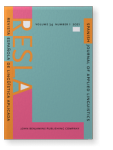Vol. 34:1 (2021) ► pp.144–170
Vol. 34:1 (2021) ► pp.144–170
Blurred lines
Un análisis crítico del discurso feminista
Las canciones son un área de especial interés para el estudio de las ideologías de género. La música no es sexista, pero sus letras sí pueden presentar contenidos que resultan problemáticos desde la perspectiva de género. El objetivo de este trabajo es realizar un análisis crítico del discurso feminista de la canción Blurred Lines (2013) interpretada por R. Thicke, haciendo especial hincapié en el estudio de las metáforas conceptuales tal y como se manifiestan en su estructura lingüística. Se trata de una canción que ha cosechado un innegable éxito a nivel social, pero que también ha sido objeto de controversia y críticas negativas. El análisis llevado a cabo nos ha permitido mostrar cómo esta canción transmite valores que pueden contribuir a consolidar y perpetuar ideologías que promueven la desigualdad entre hombres y mujeres y el sexismo.
Article outline
- 1.Introducción
- 2.Marco Teórico
- 3.Discusión: Análisis crítico-feminista de Blurred lines
- 4.Conclusiones
- Notas
-
Referencias
Article language: Spanish
